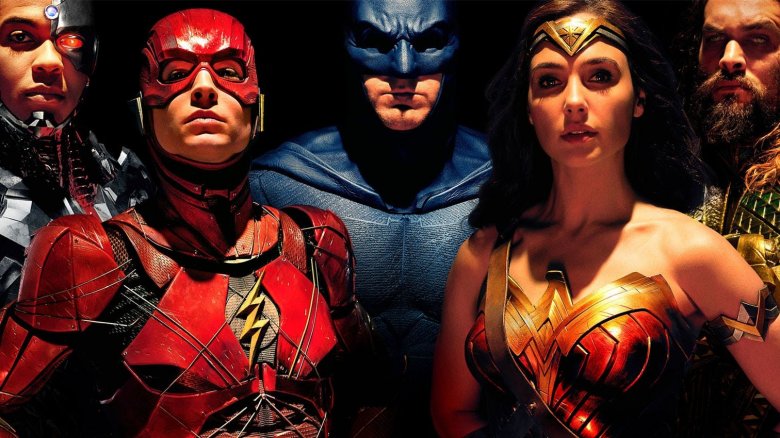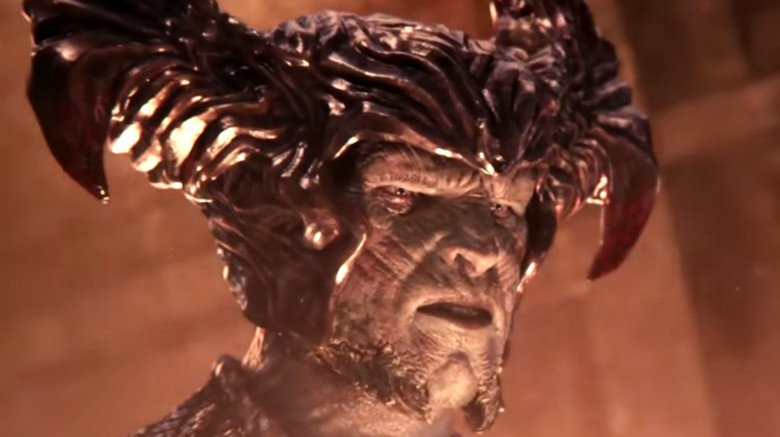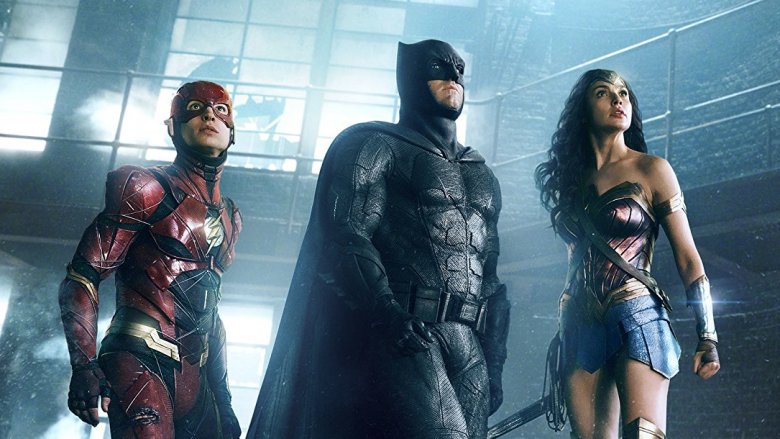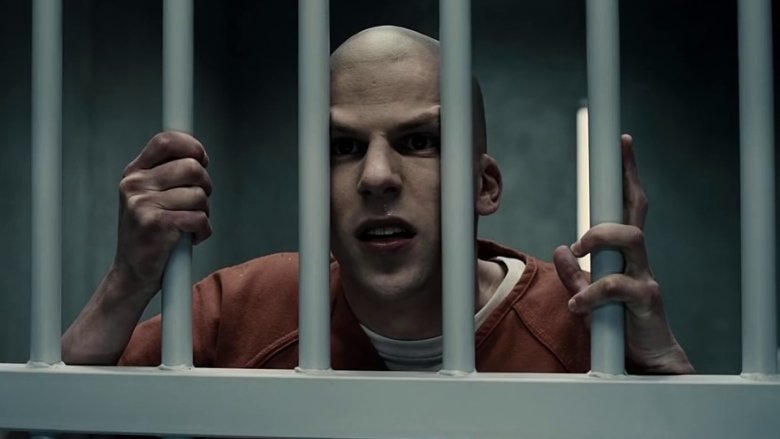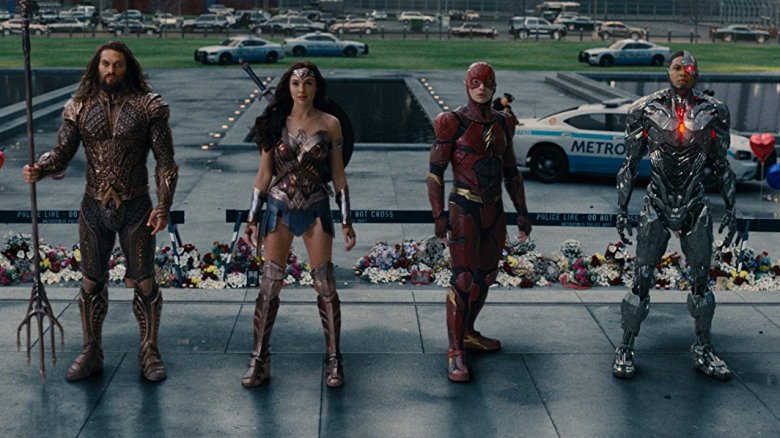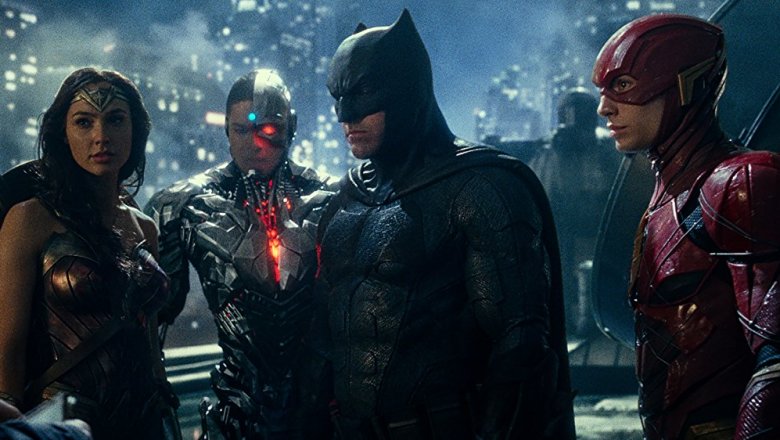The Ending Of Justice League Explained
Justice League, the latest installment in the DCEU, is here, and there's plenty to unpack once the two hour super-slugfest has ended. We've got tons of classic characters finally making their real debuts, we've got teases for future movies in the franchise—we've got Batman cracking jokes and Flash falling down a lot. What more could you want? Well, how about an explanation as to what that ending was about? Without further ado, let's open up the cinematic Mother Box and explain the ending of Justice League. And just in case you were wondering: spoilers ahead.
Steppenwolf steps out
So the Justice League has finally made its way to the big screen. DC Comics' biggest and best superhero team has formed, and they've teamed up to fight the classic comics villain...Steppenwolf. Yes, everyone's favorite bad guy, Steppenwolf.
Wait, you never heard of Steppenwolf? Well, don't worry. Most folks haven't. To be honest, even most comic book nerds would be hard pressed to tell you who, exactly, Steppenwolf is. All you really need to know is that he's one of the less exciting henchpeople serving under one of DC's biggest bad guys, Darkseid, who rules over the crappy planet Apokolips. When Steppenwolf got mobbed by his own Parademon soldiers, he boom tubed his way off of Earth. Where'd he go? Well, there's a good bet he went back home to tell Darkseid that he'd failed to turn Earth into a new version of Apokolips with the three Mother Boxes. Speaking of which...
New New Genesis
It's never quite clear what, exactly the three Mother Boxes are going to do to Earth once they...well, once they whatever it is they were doing before Cyborg and Superman split them apart. But the comics that inspired elements of the movie might hold some clues.
While Darkseid and Steppenwolf hang out on the dank, always-engulfed-in-flames planet of Apokolips, they're also at war with their opposite: New Genesis. For those who don't know, New Genesis is basically the jam, and everyone there is super happy all the time. In short: New Genesis is good, Apokolips is bad. These are appropriate names for these planets, people.
Anyway, it's heavily implied that Steppenwolf's plan to merge the three Mother Boxes would result in Earth becoming a new version of Apokolips for Darkseid to rule over. And when Cyborg and Superman separated the three Mother Boxes, the area surrounding the climactic battle bloomed to life with strange, alien flowers. There isn't a lot of information to help us understand what, exactly, happened there at the end. But could it be that separating the boxes had the opposite effect? Maybe instead of Earth turning into a New Apokolips, we instead got a glimpse of New New Genesis...or maybe the filmmakers just wanted to make that crummy area around the nuclear reactor look nice after the super people got done punching each other. Either one.
A Super-Flashy footrace
The mid-credits scene gave longtime comic fans a fun moment when the Flash and Superman challenge each other to a race. This, of course, is a reference to an often revisited story in the comics—the Flash and Superman have been racing each other for decades now. It's not really important to know which one is faster. Though it would be nice to know if Barry really did have to take everybody to brunch. We probably won't find out the answer until the Justice League gets back together in the next movie. Speaking of which...
A league of their own
The very end of the movie saw the return of Jesse Eisenberg's Lex Luthor, not to mention the first movie appearance of Slade Wilson, better known as Deathstroke, the Terminator. When the two meet up on Luthor's yacht, the bald nerd says that he'd like to establish a league of his own. And yes, you're not wrong to think he's making reference to everyone's favorite movie about ladies playing baseball in the '40s—but he's not. Sorry.
In fact, he's referring to a group of supervillains who, in the comics, would band together to try and take over the world from time to time. These bad guys have gone through plenty of different rosters and names over the years: the Injustice League, the Injustice Gang, the Legion of Doom, One Direction — it's tough to know, exactly, which name they'll go by when they make their return in future DCEU films. But one thing's clear: they'll have plenty of heroes to fight.
Room for more?
Near the very end credits, Bruce, Diana, and Alfred take a tour of the dilapidated old Wayne Manor and start planning their new Justice League clubhouse—or Hall of Justice, if you will. Bruce mentions a big round table with six seats, while Diana adds, "with room for more." Naturally, this implies that more superpowered folks will be joining the DCEU soon.
It's probably a bit too soon to say who, exactly, will add their chairs to the table, but we do have some clues. For instance, Warner Bros. has a Shazam! movie in the works, not to mention another run at adapting the Green Lantern characters to the big screen. Did anyone else catch the Green Lantern putting in an appearance during the big fight scene flashback near the beginning of the movie?
There are plenty of DC characters who will supposedly join the members of the Justice League at the big table in the not-so-distant future. Well, probably. And while we're on that subject...
The future of the DCEU
While Justice League will certainly earn a lot of money for Warner Bros., there are larger questions at work regarding the future of the DC Extended Universe. For instance, out of the five movies that comprise the cinematic universe, only one—Wonder Woman—managed to earn a Certified Fresh rating from review aggregator Rotten Tomatoes. Like Man of Steel, Batman v Superman, and Suicide Squad before it, Justice League's score on the site points to an overall consensus that critics just don't really like the movie overall. While fans of the DCEU might not put much stock in what the critics have to say, general audiences might start staying away from DC-based movies in the future, and that will hurt Warner Bros.' ability to continue expanding its cinematic universe.
In fact, news hit shortly before Justice League premiered that WB's execs have put production of the Flash's long-delayed solo movie on pause while they wait to see what happens with its team-up film. And there's a Joker-focused movie in the works that will apparently be separate from the current slate of interconnected movies. The implications are clear: Warner Bros. is hedging its bets, and might not be all that committed to delivering on the teases that show up in Justice League at all. After all, the end of Dark Knight Rises sure seemed to indicate that there was plenty of room for another batch of movies starring a new guy as Batman. And DC even tried to kickstart its cinematic universe once before Man of Steel with Green Lantern—and we all remember how that turned out.
All in all, just because we're five movies deep doesn't mean that Warner Bros. will keep the DCEU alive—at least not in its current form. It's already got several different interconnected superhero universes going on network TV, all while these movies with the same characters played by different actors are competing for fans' affection. In the end, Warner Bros. doesn't need to keep this universe alive, and once the bad reviews start to actually affect ticket sales, it probably won't.
Then again, we're still getting Fast and the Furious movies despite half of them being rotten...so you never know.
